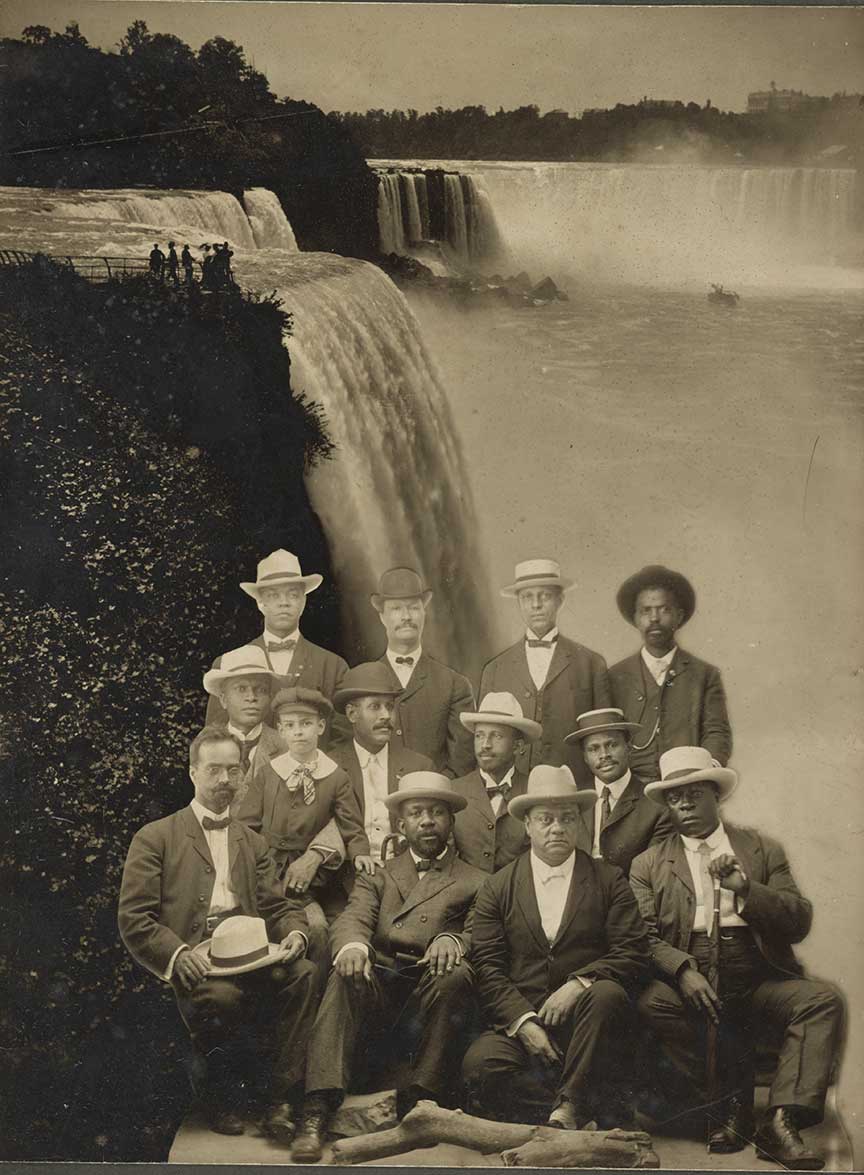1904 Niagara Movement Begun

Founders of the Niagra Movement (l. to r.) front row, Henry L. Baily of Washington, D.C., Clement G. Morgan of Massachusetts, W.H.H. Hart of Washington, D.C., and B.S. Smith of Kansas; middle row, Frederick L. McGhee of Minnesota, Norris Bumstead Herndon, son of Alonzo Herndon, J. Max Barber of Illinois, W.E.B. Du Bois of Alanta, Georgia, and Robert Bonner of Massachusetts; back row, H.A. Thompson of New York, Alonzo F. Herndon of Georgia, John Hope of Georgia, and an unidentified man, possibly James R.L. Diggs. (Source: W.E.B. Du Bois Library, Special Collections & University Archives, UMass Amherst)
In 1904, W.E.B. Du Bois and other Black intellectuals met near Niagara Falls. They issued a call for full equality in American life for Blacks. Du Bois became a national intellectual leader with the publication the year before of "The Souls of Black Folk." The meeting began the Niagara Movement.
In 1904, W.E.B. Du Bois and a group of Black intellectuals convened near Niagara Falls to address the pervasive racial inequalities in the United States. This meeting, pivotal in the fight for civil rights, marked the inception of the Niagara Movement. It was an audacious call for full equality in American life for Black people, challenging the prevailing ideologies of the time and setting the stage for future civil rights activism. Du Bois, who had risen to national prominence with his seminal work, “The Souls of Black Folk,” published the previous year, emerged as a leading voice in this burgeoning movement.
“The Souls of Black Folk” was a profound examination of the Black experience in America, offering both a critique of the systemic racism and a vision for Black empowerment. Du Bois’s concept of “double consciousness”—the internal conflict experienced by Black Americans, who had to reconcile their African heritage with their American citizenship—resonated deeply with many. This work not only established Du Bois as a national intellectual leader but also laid the intellectual groundwork for the Niagara Movement. His advocacy for higher education, political engagement, and civil rights was in stark contrast to the more conciliatory approach advocated by Booker T. Washington, who emphasized vocational training and accommodation.
The Niagara Movement was formally launched in 1905 when Du Bois and 29 other Black leaders met at the Erie Beach Hotel in Ontario, near Niagara Falls. The group was barred from meeting on the U.S. side due to racial discrimination, underscoring the very issues they sought to combat. The members of the Niagara Movement were united by a shared belief in the necessity of direct action and protest to achieve social and political equality. They issued a powerful declaration of principles, calling for an end to racial segregation and disenfranchisement, and demanding equal economic and educational opportunities for Black Americans.
The Niagara Movement was significant for several reasons. Firstly, it marked a shift from the accommodationist strategies that had dominated Black leadership in the late 19th and early 20th centuries. The movement’s insistence on immediate and full civil rights was a radical departure from the gradualism espoused by Booker T. Washington. Secondly, it laid the groundwork for future civil rights organizations, most notably the National Association for the Advancement of Colored People (NAACP). Many of the Niagara Movement’s members would later become key figures in the NAACP, and the movement’s principles would inform the NAACP’s advocacy and legal strategies.
Despite its groundbreaking stance, the Niagara Movement faced significant challenges. Internal divisions and external pressures limited its effectiveness. The movement’s refusal to compromise and its focus on an educated elite alienated some segments of the Black community. Additionally, it faced intense opposition from both white supremacists and those within the Black community who supported Washington’s approach. These factors, coupled with financial difficulties and logistical challenges, hindered the movement’s ability to sustain itself over the long term.
Nevertheless, the Niagara Movement achieved several notable successes. It organized annual conferences that brought together Black leaders and activists from across the country, fostering a sense of solidarity and shared purpose. It also produced influential publications and statements that articulated the aspirations and grievances of Black Americans. These efforts helped to keep the issue of racial equality in the national spotlight and inspired a new generation of activists and intellectuals.
The legacy of the Niagara Movement is most clearly seen in its influence on the NAACP, which was founded in 1909, just a few years after the movement’s inception. The NAACP adopted many of the Niagara Movement’s goals and strategies, and Du Bois continued to play a leading role in the organization. Through its legal battles, advocacy, and public education efforts, the NAACP would go on to become one of the most important civil rights organizations in American history.
 >
>